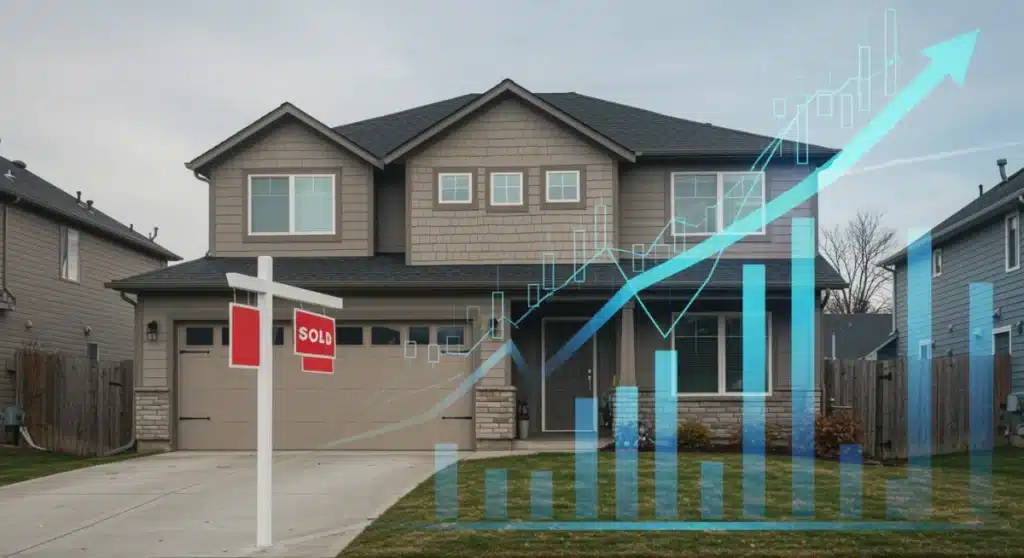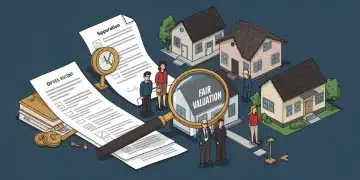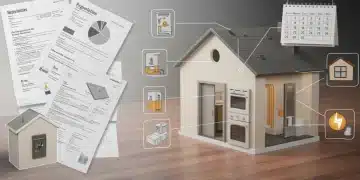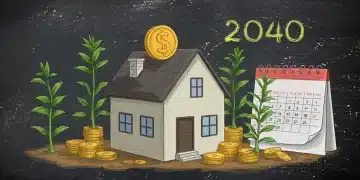HELOCs 2025: Leveraging Up to 85% of Your Home’s Value

Home Equity Lines of Credit (HELOCs) in 2025 are allowing homeowners to leverage up to 85% of their property’s value, providing substantial financial flexibility for various needs.
Breaking news in the financial sector reveals a significant shift: Home Equity Lines of Credit (HELOCs) 2025: Leveraging Up to 85% of Your Home’s Value is becoming a mainstream reality, offering homeowners unprecedented access to their property’s stored wealth. This development could redefine how individuals finance major expenses, from home renovations to educational costs.
Understanding the 85% LTV Shift in HELOCs
The financial landscape is evolving, and one of the most impactful changes for homeowners in 2025 is the widespread availability of Home Equity Lines of Credit (HELOCs) allowing up to 85% Loan-to-Value (LTV). This means that eligible homeowners can now borrow a significantly larger portion of their home’s appraised value, providing greater financial flexibility than ever before. This expanded access to equity is driven by a combination of factors, including robust housing markets in many regions and lenders’ increasing confidence in property values.
Historically, HELOCs typically capped out at around 75% or 80% LTV. The current trend towards 85% reflects a competitive market among lenders and a recognition of the substantial equity many homeowners have accumulated. This higher LTV opens doors for various financial strategies, enabling homeowners to address immediate needs or pursue long-term goals with considerable capital at their disposal.
What is Loan-to-Value (LTV)?
Loan-to-Value (LTV) is a critical metric in real estate finance, representing the ratio of the loan amount to the appraised value of the property. For HELOCs, a higher LTV means you can borrow a larger percentage of your home’s equity. This calculation is straightforward: divide the loan amount by the home’s appraised value and multiply by 100 to get a percentage.
- Appraised Value: The current market value of your home, determined by a professional appraisal.
- Existing Mortgage Balance: The outstanding amount on your primary mortgage.
- HELOC Limit: The maximum amount you can borrow through your HELOC.
Eligibility Requirements for 85% LTV HELOCs
While the prospect of leveraging up to 85% of your home’s value is enticing, not all homeowners will automatically qualify. Lenders, as reported by industry analysts, are maintaining stringent criteria to mitigate risk, especially with higher LTV ratios. Key factors for eligibility in 2025 include a strong credit score, a manageable debt-to-income (DTI) ratio, and a solid payment history on your existing mortgage.
Financial institutions are emphasizing responsible lending, meaning applicants must demonstrate a clear ability to repay the borrowed funds. This typically involves a thorough review of personal finances, employment stability, and overall financial health. The higher LTV offering is a benefit for well-qualified borrowers, reinforcing the importance of maintaining good financial standing.
Key Qualification Factors
To qualify for a HELOCs 2025: Leveraging Up to 85% of Your Home’s Value, lenders will scrutinize several aspects of your financial profile. These factors are designed to ensure that both the borrower and the lender are protected from potential financial distress.
- Credit Score: A strong credit score, typically above 700, is often required. This demonstrates a history of responsible borrowing and repayment.
- Debt-to-Income Ratio (DTI): Lenders prefer a DTI ratio below 43%, indicating that a manageable portion of your income goes towards debt payments.
- Home Equity: You must have substantial equity built up in your home to qualify for an 85% LTV HELOC. The difference between your home’s value and your outstanding mortgage balance determines your available equity.
- Employment Stability: Consistent employment and income history are crucial. Lenders want assurance that you have a stable source of funds to make payments.
Strategic Uses of an 85% LTV HELOC
With the ability to access a larger portion of home equity, homeowners are finding diverse and strategic ways to utilize these funds. According to recent financial reports, common applications for HELOCs 2025: Leveraging Up to 85% of Your Home’s Value include significant home improvements, consolidating high-interest debt, funding education, and even making strategic investments. The flexibility of a HELOC, which allows you to draw funds as needed, makes it a powerful financial tool for various life events.
Unlike a traditional home equity loan, which provides a lump sum, a HELOC functions more like a credit card, allowing for multiple draws and repayments during a set draw period. This feature is particularly beneficial for ongoing projects or unexpected expenses, providing adaptable financial support without committing to a large, fixed-sum loan upfront.
Popular Applications for Increased Equity Access
The amplified borrowing power offered by 85% LTV HELOCs means homeowners can tackle larger projects or address more significant financial challenges. This increased access can be a game-changer for many households.
- Home Renovations: Funding major remodels or additions that can increase property value and enhance living quality.
- Debt Consolidation: Paying off high-interest credit card debt or personal loans, potentially saving thousands in interest over time.
- Education Expenses: Covering tuition costs, student loans, or other educational investments for family members.
- Investment Opportunities: Funding business ventures or other investments, though this carries inherent risks and requires careful consideration.
- Emergency Fund: Creating a robust financial safety net for unforeseen circumstances, offering peace of mind.
Risks and Considerations with Higher LTV HELOCs
While the opportunity to leverage up to 85% of your home’s value is appealing, it’s crucial to understand the associated risks. As reported by financial advisors, a higher LTV ratio means you have less equity remaining in your home, which can expose you to greater financial vulnerability if property values decline or interest rates rise. It’s essential to approach a HELOCs 2025: Leveraging Up to 85% of Your Home’s Value with a clear repayment plan and a thorough understanding of the terms and conditions.
The variable interest rates typical of HELOCs can also pose a risk. If rates increase, your monthly payments could become significantly higher, potentially straining your budget. Experts recommend stress-testing your finances to ensure you can comfortably manage payments even if interest rates climb. Prudent financial planning is paramount when taking on additional debt, especially one secured by your home.

Mitigating Potential Financial Hazards
Being aware of the risks is the first step; taking proactive measures to mitigate them is the next. Responsible borrowing involves understanding your financial limits and planning for various scenarios.
- Budgeting: Create a detailed budget to ensure you can comfortably make HELOC payments, even with potential interest rate increases.
- Emergency Fund: Maintain a separate emergency fund to cover unexpected expenses and avoid further reliance on your HELOC.
- Interest Rate Monitoring: Stay informed about market interest rate trends to anticipate potential changes in your HELOC payments.
- Understanding Terms: Carefully read and understand all terms and conditions of your HELOC agreement, including draw periods, repayment periods, and potential fees.
The Impact of Economic Conditions on HELOCs in 2025
The broader economic environment plays a significant role in the availability and attractiveness of HELOCs 2025: Leveraging Up to 85% of Your Home’s Value. As of early 2025, stable housing markets and a relatively steady interest rate environment are contributing to lenders’ willingness to offer higher LTV HELOCs. However, any shifts in inflation, employment rates, or monetary policy could influence these offerings.
News reports indicate that central banks are closely monitoring economic indicators, and any decisions regarding interest rates will directly affect HELOC costs. Homeowners considering this financing option should stay informed about economic forecasts and how they might impact their borrowing costs and home values. The dynamic nature of the economy means that what is favorable today could change in the future, necessitating careful consideration and adaptability.
Economic Factors to Watch
Several macroeconomic factors can directly influence the HELOC market and the terms available to borrowers. Keeping an eye on these indicators can help homeowners make informed decisions.
- Interest Rate Trends: Changes in the federal funds rate directly impact the prime rate, which most HELOCs are tied to.
- Housing Market Stability: A stable or appreciating housing market encourages lenders to offer higher LTVs, as their collateral is more secure.
- Inflation Rates: High inflation can lead to higher interest rates, increasing HELOC costs.
- Employment Data: Strong employment figures indicate a healthy economy, which can positively influence lending conditions.
Comparing 85% LTV HELOCs with Other Financing Options
For homeowners looking to access their home equity, an 85% LTV HELOC is just one of several available options. It’s crucial to compare it against alternatives like traditional home equity loans, cash-out refinances, and personal loans to determine the best fit for your specific financial situation. Each option carries distinct advantages and disadvantages, particularly regarding interest rates, repayment structures, and flexibility. The choice depends heavily on your immediate needs, long-term financial goals, and risk tolerance.
A HELOCs 2025: Leveraging Up to 85% of Your Home’s Value offers unparalleled flexibility with its revolving credit line feature, making it ideal for ongoing or unpredictable expenses. However, if you need a predictable, fixed-rate lump sum, a home equity loan might be more suitable. Cash-out refinances, while offering a new mortgage with a lower rate, typically involve higher closing costs and a longer application process.
Key Differences in Financing Options
Understanding the nuances between different financing vehicles is essential for making an informed decision about leveraging your home’s equity.
- HELOC vs. Home Equity Loan: HELOCs offer a revolving credit line with variable rates; home equity loans provide a lump sum with fixed rates.
- HELOC vs. Cash-Out Refinance: HELOCs are a second mortgage, keeping your primary mortgage intact; cash-out refinances replace your existing mortgage with a larger one.
- HELOC vs. Personal Loan: Personal loans are unsecured, often have higher interest rates, and shorter repayment terms, but do not use your home as collateral.
| Key Aspect | Brief Description |
|---|---|
| 85% LTV HELOCs | Homeowners can borrow up to 85% of their home’s appraised value, offering significant financial leverage. |
| Eligibility | Requires strong credit, low DTI, substantial home equity, and stable employment for approval. |
| Strategic Uses | Ideal for home improvements, debt consolidation, education funding, and other large expenses. |
| Key Risks | Variable interest rates, reduced home equity, and potential for increased payments if rates rise. |
Frequently Asked Questions About 85% LTV HELOCs
A HELOC is a revolving line of credit secured by your home’s equity, allowing you to borrow and repay funds as needed. A home equity loan provides a lump sum with a fixed interest rate and repayment schedule from the outset.
Generally, yes. While common uses include home renovations and debt consolidation, the funds from a HELOC can typically be used for any purpose, including education expenses, investments, or unforeseen emergencies, subject to lender terms.
Your credit score is a crucial factor. A higher score, typically above 700, indicates financial reliability and increases your chances of approval for an 85% LTV HELOC, often securing better interest rates and terms.
If home values decline, your LTV ratio increases. Lenders may reduce your credit limit or even freeze your HELOC, leading to less access to funds. This highlights the importance of understanding market risks.
HELOCs typically have variable interest rates, meaning they can fluctuate with market conditions, often tied to the prime rate. This can lead to changes in your monthly payment amounts over the life of the loan.
Looking Ahead
The emergence of HELOCs 2025: Leveraging Up to 85% of Your Home’s Value marks a significant development for homeowners seeking financial flexibility. As the market continues to adapt, it will be crucial for both lenders and borrowers to monitor economic trends and regulatory changes. This enhanced access to home equity could reshape personal finance strategies, but also demands a heightened awareness of risk management. We anticipate continued innovation in home equity products, further empowering homeowners while emphasizing prudent financial decision-making in a dynamic economic landscape.





